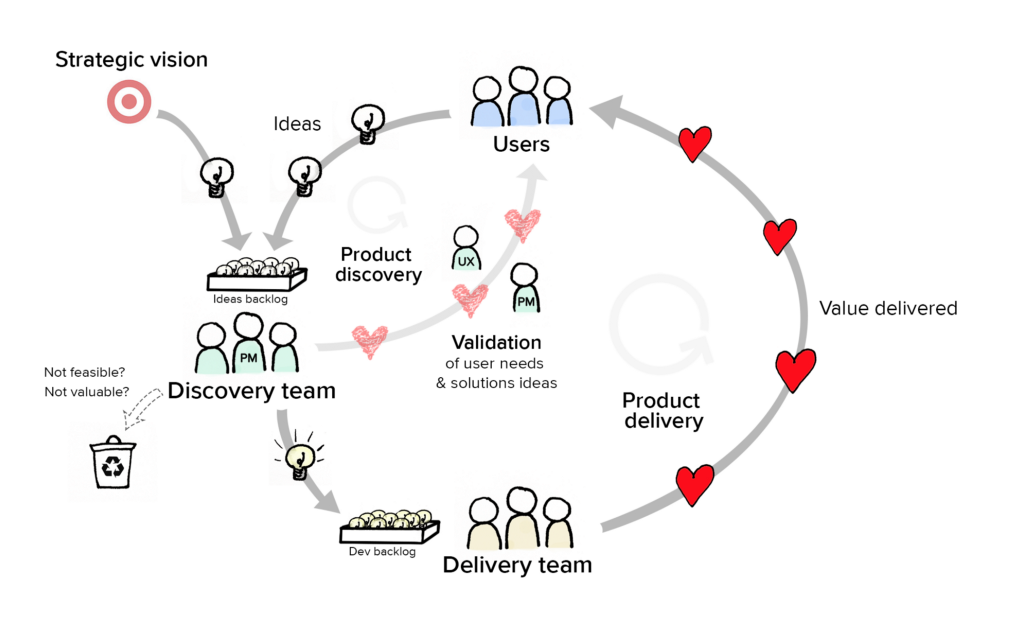Activity Tracking
Dual Track Agile process, from Kevin Albrecht, adapted by Dottie Schrock
Scroll down for the good stuff
↓
01. Overview and my role
02. Recruiters’ needs & pain points
03. Problem statement
04. Ideation and market research
05. Delivery phase
06. Feature evaluation
07. Bottom Line
01. Overview and my role
Upon joining Taledo, the company had a new strategy to consider both the external companies using the SaaS produc and the internal Recruitment Consultants (RCs) as the target user group. This allowed me to work closely with the end users, many of whom were my collegues, on weekly workshops that turned into a fun and interactive way to find and solve problems, while having space for easy feedback loops throughout the process. Basically, a similar approach to the following:
02. Recruiters’ needs & pain points
As I delved into the world of recruiters and their daily struggles, I uncovered a wealth of information about their personalities, behaviors, and pain points, which were then synthesized by creating personas, which helped me understand the varying perspectives and needs of different users.
03. Problem statement
Activity Tracking was the topic to be addressed, as it set at the top of priorities with its problem statement as it follows:
The main user group does not have a full overview of the activities that each of their colleagues has had with their candidates and clients. This opens up the problem of lack of communication, organization, and transparency, affecting the trust in the product and service.
04. Ideation and market research
During the weekly workshops, ideas were flowing in sticky note brainstorming sessions and diagram discussions. To bring our concepts to life, we challenged the RCs to illustrate their ideas on paper.
Sketches from the Recruitment Consultants
On the market analysis, I looked together with the recruiters at other Applicant Tracking Systems (ATS) that were tackling similar issues in their software. Following Jakob’s Law, “Users spend most of their time on other sites”, which means that they expect certain usability patterns between several tools they use, to reduce their cognitive load of having to learn something new.
With the research and discussion of the wireframes and user flows, I had juicy content to craft a medium-fidelity prototype, for the users to test, by providing insightful feedback. It was fascinating to see that as we got closer to the final product, they began to understand what was truly important for the Minimum Viable Product (MVP).
5. Delivery phase
Developer handoff
Lo-fi and Hi-fi wireframes for the logged activities
6. Feature evaluation
The initial results for the Activity Tracking feature were not promising, so a more quantitative approach was taken to understand why. The main issue was found to be the slow adoption of the new way of working by target users, despite seeing the value in the feature. Despite this, the feature was released as it had the potential to improve recruiters' daily lives and had a positive impact during the Design Thinking process. With management's intervention, the team encouraged each other to track activities with candidates, and it was a success. Usage and satisfaction increased, resulting in a 23-point increase in the Net Promoter Score in just one month, with users praising the new way of working with the Product Team.
7. Bottom Line
The next steps would be to continuously evaluate the feature, while closely with users to make improvements and add new elements that will make their lives easier. Just like people change, it is also important to understand that the product needs to adapt constantly to their needs.
Collaboration was key throughout the project. I grasped the opportunity of sitting in the same office as the target user group to conduct ethnographic research and team up with them to design the feature. This empathy led to improved trust and usage of the product and motivated stakeholders to work towards a meaningful outcome.




